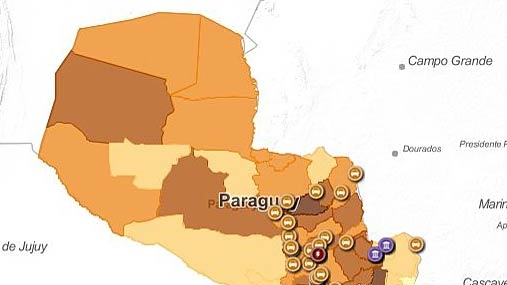CHALLENGE
Upon seeking Bank intervention, Paraguay’s economy was hampered by an inefficient payments system that relied on manual, paper-based systems, posing important risks to the stability and efficiency of payments. Out of twenty-six countries that form part of the LAC region, Paraguay was one of five without a real-time gross settlement system. These are critical to support the migration of payments from paper-based to electronic instruments.
The legal and regulatory framework for payments in Paraguay was nearly nonexistent and large payments in the region were mainly conducted via cheques, creating credit and liquidity risks. Thus, the paper-based system created important economic delays that literally slowed Paraguay’s economy and stunted its economic growth, resulting in an estimated economic cost equivalent to 1% of Paraguay’s total GDP.
APPROACH
Through a non-lending technical assistance project, the World Bank team worked with the BCP team over a period of six years to improve Paraguay’s payments system. The World Bank team employed their accumulated knowledge of international standards and their technical, global expertise from reforming payments systems to Paraguay’s unique financial context to guide and inform their efforts.
They assisted in the creation of the legal and institutional framework necessary to improve the system and worked jointly with BCP authorities to draft the National Payment System Law. Passed by Congress in March 2012, the law supported a regulation regarding the creation of an oversight unit within the BCP, the team also set specific credit card regulations and created the overall legal foundation for guidelines governing both payments and the operation of the system, among other issues. Commercial banks and other stakeholders were consulted and a feedback loop was designed to gather, monitor, document and further incorporate information and suggestions.
RESULTS
The new electronic payments system, the Automated Transfer System (ATS), went live in Spring 2013. BCP is currently undertaking the process of transitioning payments to the ATS.
This initiative has had important intermediary results, especially with regards to the establishment of regulatory structures that are the critical backbone for financial system reform.
These include:
- Approval of the National Payment System Law.
- The creation of an oversight body for the new payments system within the BCP (approved by the BCP Board).
- Operational rules for the new payment system are created and active.
- The framework for the new Automated Transfer System (which has the capacity to handle both high and low value electronic payments) has been completed.
WORLD BANK GROUP CONTRIBUTION
The World Bank contributed U$S 65,000 to this project while total project cost was significantly higher as the Bank was hired by the BCP, who covered the majority of project costs.
PARTNERS
The Bank team worked very closely with the BCP, as public officials from this agency sought out Bank support directly, covering almost the entirety of project costs. The Bank also involved commercial banks, other private sector representatives as well as a multitude of relevant stakeholders in the design and execution of this initiative, incorporating input and tweaking project plans accordingly. The involvement of stakeholders from the outset of project design will have important implications to foster a sustained interest and stakeholder buy-in to the new ATS system.
MOVING FORWARD
The Bank’s work on Paraguay’s Payment System will also serve as a model for other countries looking towards implementing similar reforms. Most importantly, this project exemplifies the potential for impact of Bank expertise when solicited and employed directly by government counterparts committed to affecting real change in their country.
BENEFICIARIES
All payments between financial entities will be completed in a safe and efficient manner, substantially reducing credit and liquidity risk in the payments system and thereby reducing financial systemic risk. In addition, as retail payments become streamlined into the system, it is expected that the processing of low-value payments such as government salaries, credit card transactions, government payments and the like will generate substantial benefits for financial transactions as well as further enable financial inclusion through the faster adoption of electronic means of payments, benefitting individuals throughout the private and public sectors.

